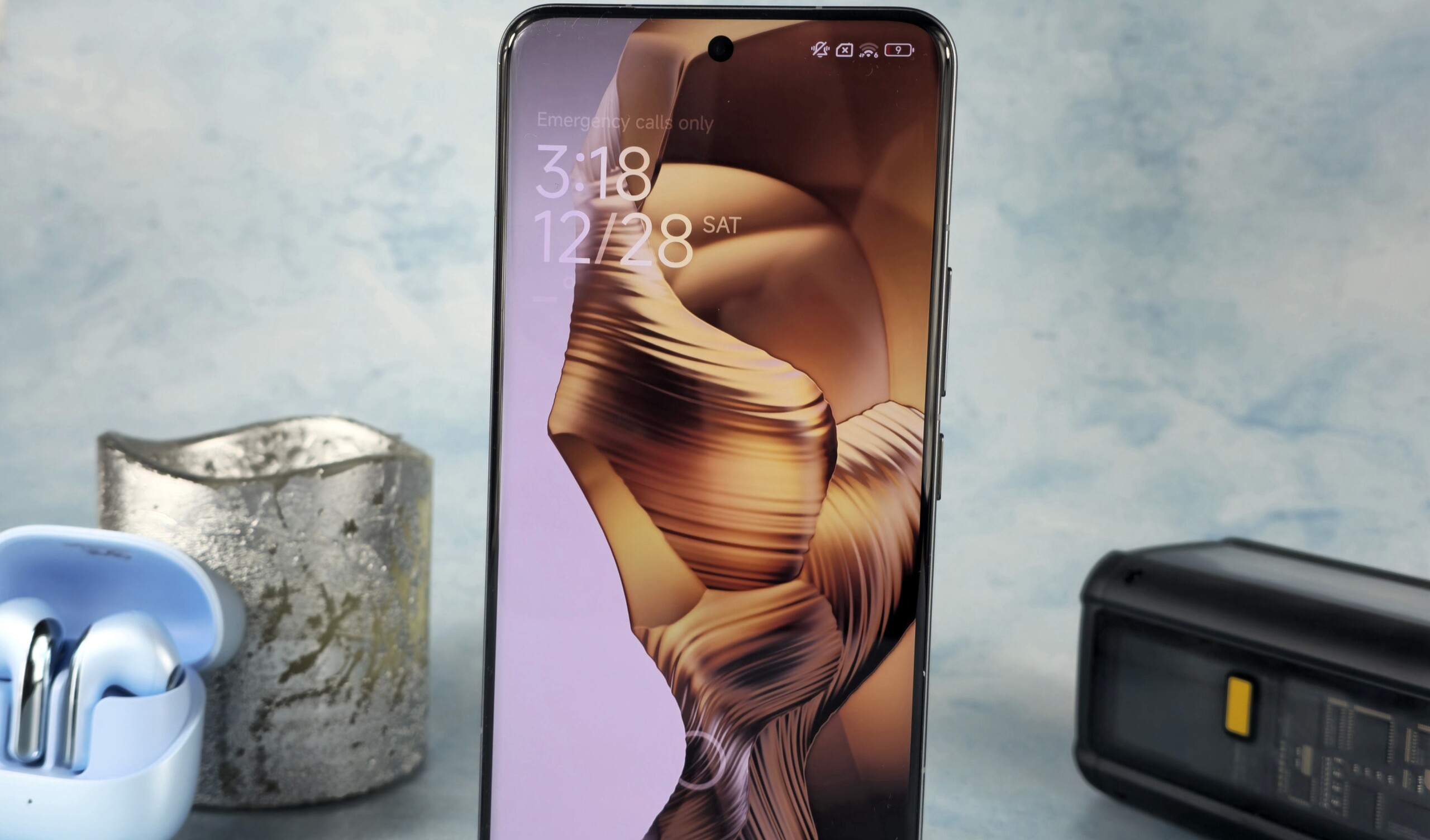
Xiaomi 15 Pro review - One of the most efficient flagship smartphones thanks to a special display
Cooling makes all the difference.
Buyers of a Xiaomi 15 Pro can look forward to the best smartphone hardware in the shape of a Snapdragon 8 Elite, a huge silicon-carbon battery, and Leica Summilux cameras. The Xiaomi phone additionally has an extremely attractive price tag—but this comes with a catch.Marcus Herbrich, 👁 Florian Schmitt (translated by Daisy Dickson) Published 🇩🇪 🇫🇷 ...
Verdict on the Xiaomi 15 Pro
In this modern era of the smartphone, efficiency is becoming increasingly important and in the future, this may well become a deciding factor in order to use resources optimally. In this context, efficiency means that a cell phone performs its tasks reliably without consuming unnecessary energy.
Xiaomi has also identified this as a sales strategy for its 15 Pro. In addition to its high-performance and very efficient 3nm chipset from Qualcomm, the Chinese manufacturer's latest flagship uses a particularly energy-saving, yet extremely bright OLED panel. We cannot clarify in detail to what extent the new display of the Xiaomi 15 Pro played a role in our consumption measurement, but the high-end phone is certainly very efficient as an overall package. Competitors, such as the Nubia Z70 Ultra, sometimes consume more than twice as much energy.
The Xiaomi flagship additionally performs better than the competition, such as the Oppo Find X8 Pro, when it comes to cooling and consistency. Although the Snapdragon 8 Elite is throttled moderately, the 15 Pro is far from having its performance halved, as is the case with the OnePlus 13.
We see some room for improvement concerning its installed cameras. Photos taken on the Xiaomi phone are by no means bad, but the 15 Pro can't quite come close to the level of a Vivo X200 Pro. Chinese manufacturers, like Xiaomi, also need to improve on their transparency. Anyone considering importing the 15 Pro should also take into account the restrictions of the Chinese software (limited languages, no Android Auto, etc.).
Pros
Cons
Price and availability
In China, the Xiaomi phone has an MRSP of 5,299 Yuan (approx. $726). You can import the phone via our partner Trading Shenzhen for $839.74.
Possible alternatives compared
Image | Model / Review | Price | Weight | Drive | Display |
|---|---|---|---|---|---|
| Xiaomi 15 Pro Qualcomm Snapdragon 8 Elite ⎘ Qualcomm Adreno 830 ⎘ 16 GB Memory, 1024 GB | Amazon: 1. $4.99 Kicvbnco 3 Pack For Xiaomi 1... 2. $15.99 AKABEILA [3 Pack Privacy Scr... 3. $6.99 TMahhbid 2pcs Hydrogel Film ... List Price: 810€ | 213 g | 1 TB UFS 4.0 Flash | 6.73" 3200x1440 521 PPI AMOLED | |
| OnePlus 13 Qualcomm Snapdragon 8 Elite ⎘ Qualcomm Adreno 830 ⎘ 16 GB Memory, 512 GB | Amazon: 1. $899.99 OnePlus 13, 16GB RAM + 512GB... 2. $12.58 JZG 3 Pack Screen Protector ... 3. $599.99 OnePlus 13R, 12GB RAM + 256G... List Price: 720€ | 213 g | 512 GB UFS 4.0 Flash | 6.82" 3168x1440 510 PPI AMOLED | |
| Vivo X200 Pro Mediatek Dimensity 9400 ⎘ ARM Immortalis-G925 MC12 ⎘ 15 GB Memory, 512 GB | Amazon: 1. $7.51 MAOUICI Glass for Vivo X200 ... 2. $11.49 TNKISRY Tempered Glass for V... 3. $10.99 TNKISRY Cover for Vivo X200 ... List Price: 850€ | 223 g | 512 GB UFS 4.0 Flash | 6.78" 2800x1260 453 PPI OLED | |
| Samsung Galaxy S24+ Samsung Exynos 2400 ⎘ Samsung Xclipse 940 ⎘ 12 GB Memory, 512 GB | Amazon: $788.98 List Price: 1149€ | 196 g | 512 GB UFS 4.0 Flash | 6.70" 3120x1440 513 PPI AMOLED | |
| Google Pixel 9 Pro Google Tensor G4 ⎘ ARM Mali-G715 MP7 ⎘ 16 GB Memory, 128 GB | Amazon: 1. $654.95 Google Pixel 9 Pro Fold - Un... 2. $1,099.00 Google Pixel 9 Pro - Unlocke... 3. $925.00 Google Pixel 9 Pro - Unlocke... | 199 g | 128 GB UFS 3.1 Flash | 6.30" 2856x1280 495 PPI OLED | |
| Xiaomi 14 Pro Qualcomm Snapdragon 8 Gen 3 ⎘ Qualcomm Adreno 750 ⎘ 12 GB Memory, 256 GB | Amazon: 1. $354.50 Xiaomi Redmi Note 14 Pro+ Pl... 2. $730.99 Xiaomi 14 5G (512GB + 12GB) ... 3. $313.81 Xiaomi Redmi Note 14 Pro 5G ... List Price: 790€ | 223 g | 256 GB UFS 4.0 Flash | 6.73" 3200x1440 521 PPI AMOLED |
Table of Contents
- Verdict on the Xiaomi 15 Pro
- The Xiaomi 15 Pro's specifications
- Case - The Xiaomi phone is waterproof
- Connectivity - The Xiaomi 15 Pro with a speedy USB port
- Software - The Xiaomi phone comes with Android 15
- Communication and GNSS - The Xiaomi 15 Pro uses dual GPS
- Telephone functions and call quality - The Xiaomi smartphone with dual SIM support
- Cameras - The Xiaomi 15 Pro uses the Light Fusion 900
- Accessories and warranty - The Xiaomi phone comes with a power supply
- Input devices & operation - The Xiaomi phone with a new ultrasonic sensor
- Display - The Xiaomi 15 Pro is said to be particularly energy-efficient
- Performance - The Xiaomi phone with the Snapdragon 8 Elite
- Games - The Xiaomi 15 Pro only manages 90 frames per second
- Emissions - The Xiaomi phone gets quite warm
- Battery life - The Xiaomi 15 Pro with new battery technology
- Notebookcheck total rating
In addition to the Xiaomi 15 that we have already tested, the technology giant from the Far East has unveiled its latest flagship phone, the Xiaomi 15 Pro. The high-end smartphone has some similarities to its more compact sister model—for example, its Qualcomm Snapdragon 8 Elite and selection of Leica cameras—but according to Xiaomi, it also boasts a special LTPO AMOLED display. With the same brightness, it should consume significantly less energy compared to the displays of most competitors. Moreover, it features a large 6,100 mAh battery with a silicon-carbon-based anode.
Like the Xiaomi 14 series, the Xiaomi 15 series will most likely not be available to purchase in the United States. You can still import the phone from certain retailers, however.
The Xiaomi 15 Pro's specifications
Case - The Xiaomi phone is waterproof
The Xiaomi 15 Pro's case uses high-quality materials and boasts an excellent build quality. The back, as well as the front, are made of the company's own second-generation Dragon Crystal Glass or Xiaomi Shield Glass (international name). This should make the flagship phone even more impact-resistant. An aluminum frame rounds off the exterior of the Xiaomi 15 Pro, merging seamlessly with the glass material. This makes the case feel super nice and homogeneous in your hand.
Overall, the device's design looks modern thanks to its thin display bezels and efficient front-to-surface ratio. With a case thickness of 8.5 mm and a weight of 213 grams, the Xiaomi phone isn't terribly bulky despite its massive battery.
Color selection of the Xiaomi 15 Pro (image source: Xiaomi China)
The Xiaomi 15 Pro is available in four colorways, including two more classic variants (white, gray) and two more unusual versions (silver, green). Each color has a matte finish that only shows fingerprint marks slightly. The case is certified according to the IP68 standard, which means that the design is dustproof and waterproof and will not be damaged even if you take the phone out during a rain shower. In addition, the back camera module comes with a ceramic lens, which, according to the manufacturer, is highly wear-resistant.
Connectivity - The Xiaomi 15 Pro with a speedy USB port
The available memory/storage variants of the current Xiaomi flagship—which use LPDDR5X and UFS 4.0 respectively—as well as the corresponding prices have barely changed compared to the predecessor model. While the base model only comes with 12 GB RAM, the top version has 16 GB RAM. However, Xiaomi doesn't offer a 24 GB version, like with the OnePlus 13.
Sensitive user information, such as biometric data and passwords, is protected by a dedicated, in-house chipset on the smartphone, which, according to the manufacturer, provides enhanced protection against unauthorized access by malware.
There are no real changes to its connectivity compared to the 14 Pro: Bluetooth 5.4, an NFC chip and Miracast as well as an IR blaster are all available. USB OTG, wired image output, and a fast USB port are also on board, which works with the 3.2 standard (Gen. 2) according to the phone's specifications. However, the 13 Pro's UWB chip is once again missing from the 2024 model.
Software - The Xiaomi phone comes with Android 15
The Xiaomi 15 Pro comes with the manufacturer's own second-generation HyperOS including a Play Protect certification. As Chinese versions of its products don't support Google services straight out of the box, Chinese services and Xiaomi's own services are used. However, unlike on Huawei smartphones, you don't have to go without Google services. The Google frameworks are already pre-installed in the phone's delivered state, so you'll only have to install the PlayStore manually via the in-house app store. Unfortunately, apart from Chinese and English, no other language pack can be selected. In the near future, however, the xiaomi.eu ROM will probably also be available to flash for the Pro version.
Xiaomi has only published information regarding software updates for the Chinese market. The current Xiaomi 14 generation is supplied with four years of Android upgrades and five years of security patches. Whether this also applies to the 15 Pro, which will probably only be available in China, remains to be seen.
At the time of testing, the Xiaomi phone's latest security patch was from December 2024. The speed at which these updates are rolled out is usually good with the Chinese ROM—but Xiaomi is unlikely to operate at the monthly level of Google or Samsung.
Sustainability
The 15 Pro's packaging appears to be free of plastic, but the device itself is wrapped in foil. The rest of the packaging is made of cardboard.
Xiaomi hasn't provided any precise information on the materials used and their recycling rate for its 15 series, but the manufacturer does state that it is increasing the use of recycled materials, including aluminum, gold and copper, for all smartphones. Its use of bio-based high-polymer materials in smartphones and accessories as well as recycled plastic from discarded fishing nets is also intended to minimize its ecological footprint. Detailed information will probably only be provided in the sustainability report for the global models.
Communication and GNSS - The Xiaomi 15 Pro uses dual GPS
Within your home network, the Xiaomi 15 Pro uses the modern WiFi 7 standard including MU-MIMO support, but according to the datasheet, it only uses the 2.4 and 5 GHz range to establish a connection. In our test, however, the 6 GHz band was also recognized and we measured great transfer rates of almost over 1,500 MBit/s when receiving in combination with the Asus ROG Rapture GT-AXE11000. However, its sending rates weren't the best and suffered quite a few fluctuations.
Unfortunately, we can't fully make use of WiFi 7 during our measurements, even when using the 6 GHz band. The reason for this is that suitable routers (especially with a 10 GBit LAN port) are still hard to find.
For accessing the web on the go, the flagship cell phone can use the 5G network at best and supports a wide range of frequencies—the same applies to the LTE standard. Even bands 20 and 28 are already on board the Chinese version. According to Xiaomi, the integrated modem uses artificial intelligence to always select the best possible antennas depending on how the smartphone is held. However, we don't see it as a true "world phone", as the manufacturer calls it, with its 22 supported LTE bands.
| Networking | |
| iperf3 transmit AXE11000 6GHz | |
| Google Pixel 9 Pro | |
| OnePlus 13 | |
| Xiaomi 14 Pro | |
| Samsung Galaxy S24+ | |
| Average Wi-Fi 7 (563 - 1945, n=48) | |
| Average of class Smartphone (508 - 1945, n=91, last 2 years) | |
| Xiaomi 15 Pro | |
| iperf3 receive AXE11000 6GHz | |
| Xiaomi 14 Pro | |
| Google Pixel 9 Pro | |
| Average Wi-Fi 7 (451 - 1864, n=48) | |
| Xiaomi 15 Pro | |
| OnePlus 13 | |
| Average of class Smartphone (451 - 1870, n=91, last 2 years) | |
| Samsung Galaxy S24+ | |
During our practical test, the Xiaomi phone boasted good locating abilities. However, we wouldn't have expected larger deviations from a smartphone with dual GNSS support. The Xiaomi 15 Pro accurately displayed the distance we traveled. Our Garmin Venu 2, which we used for comparison purposes, showed a very similar route. During everyday use, the Xiaomi phone's accuracy is more than sufficient for navigation tasks.
All the main satellite systems are used for its location services: Beidou (B1I + B1C+ B2a), GPS (L1+L5), Galileo (E1+E5) and GLONASS (G1) as well as QZSS (L1 + L5) with a high accuracy of 3 meters.
Telephone functions and call quality - The Xiaomi smartphone with dual SIM support
The Xiaomi 15 Pro's call quality is consistently good and the high-end smartphone does well during mobile calls in both loud and quiet environments. Voices are transmitted clearly and without distortion, and noise is effectively suppressed to ensure good intelligibility even in loud environments.
The Xiaomi 15 Pro features full dual SIM support with two nano SIM card slots using the 5G network. There is no option to integrate an eSIM into the system in the system settings of the Chinese version.
Cameras - The Xiaomi 15 Pro uses the Light Fusion 900
The 32-MPix camera on the front of the Xiaomi 15 Pro doesn't use pixel binning or autofocus. Nevertheless, the flagship phone takes good selfies with decent sharpness but images have a tendency to be overexposed. The Snapdragon 8 Elite smartphone also cuts a fine figure when recording videos thanks to its 4K60 support.
To put it positively, Xiaomi hasn't experimented with its main camera and has gone for the same sensor as the 14 Pro. The Light Hunter 900 was developed in cooperation with Leica and has a native resolution of 50 MPix, which is usually merged into 12.5 MPix photos and superpixels using 4-to-1 binning. The 1/1.31-inch-format sensor offers a beautiful depth of detail and accurate focusing as well as a very high shooting speed. However, the variable aperture control of its predecessor is now nowhere to be seen—for whatever reason. Thanks to its large f/1.44 aperture and optical stabilization, you can still take impressive shots in low light.
Similarly, nothing has changed when it comes to its ultra-wide-angle lens. The 50 MPix sensor with a focal length of 14 mm (35 mm equivalent) delivers solid to good image quality for this price range. Its focus works up to a minimum distance of five centimeters for super macro shots.
New, on the other hand, is the 120 mm Leica periscope lens based on the Sony IMX858—also with a resolution of 50 MPix and OIS. The telephoto lens with a fivefold, lossless zoom delivers good sharpness up to 10x including lots of details. In combination with the digital "AI Zoom", the Xiaomi 15 Pro enables solid zoom shots up to 20x.
The Xiaomi 15 Pro also has a lot to offer when it comes to video recording. Moving images support Dolby Vision and HDR10+ and can be recorded with up to a very high 8K resolution (30 fps) or alternatively in UHD quality at up to 60 frames per second. A Pro video mode is additionally on board.
The main camera stabilizes videos well, but it isn't possible to change lenses while recording. This is a bit of a shame, as exposure and white balance hardly vary between the cameras.
Image comparison
Choose a scene and navigate within the first image. One click changes the position on touchscreens. One click on the zoomed-in image opens the original in a new window. The first image shows the scaled photograph of the test device.
Main cameraMain cameraLow lightUltra-wide angleIn controlled lighting conditions, we analyzed the main camera's color reproduction in comparison to the actual reference colors. The 50 MP lens revealed some brightening and oversaturation when depicting the ColorChecker Passport, especially in the green and blue tones, and the Xiaomi 15 Pro did have some outliers in color fidelity (>10).
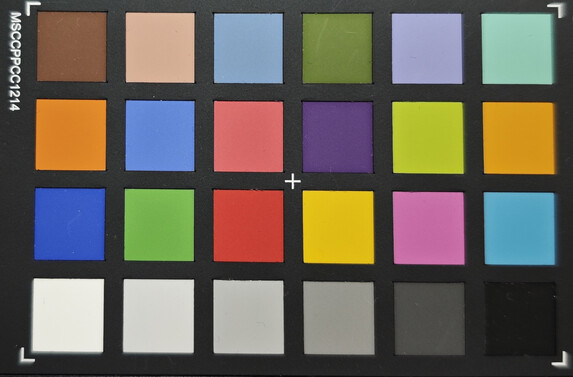

Accessories and warranty - The Xiaomi phone comes with a power supply
The phone's scope of delivery includes a 90-watt fast-charging power adapter, a protective cover, a data or charging cable (USB-A to USB-C), a SIM pin and a quick start guide. A protective film comes pre-installed on the screen. Our loaner Trading Shenzhen added an EU adapter for the charger and a USB OTG adapter to the scope of delivery of our China version.
Our imported device comes with a 12-month warranty. In the event of a warranty claim, Trading Shenzhen offers the option of sending the smartphone to a German shipping address.
Input devices & operation - The Xiaomi phone with a new ultrasonic sensor
The position of the buttons is ergonomically placed and their good pressure points allow for precise operation. Inputs on the 6.73-inch AMOLED display are also recognized accurately. Thanks to its high refresh rate of up to 120 Hz, the flagship cell phone runs smoothly during everyday use and animations look nice. Thanks to its sampling rate of up to 300 Hz, the panel also reacts quickly to touch.
A new ultrasonic sensor is available for biometric unlocking using your fingerprint. The Xiaomi phone reliably unlocked the display during our test and we never had to wait long. You can also use less-secure 2D facial recognition using the front-facing camera.
Display - The Xiaomi 15 Pro is said to be particularly energy-efficient

Xiaomi has installed an LTPO AMOLED panel with a high 1,440p resolution into its latest flagship. According to the manufacturer, the M9 material used ensures a very high light yield and therefore reduces power consumption with the same brightness as the competition. It also has a triple certification by TÜV Rheinland (flicker-free, low blue light content, "circadian-friendly").
The panel can dynamically adjust its frame rate between 1 Hz and 120 Hz and features a peak brightness of 3,200 nits according to the datasheet. Fortunately, this value was even exceeded during the APL18 test which is relevant for everyday use, and we measured 3,526 cd/m²—whereby a slightly higher brightness is often possible with HDR content on smartphones. But even so, video content with a high dynamic range is displayed super nicely, and it supports lots of standards (HDR 10+, Dolby Vision, HDR Vivid, HLG).
| |||||||||||||||||||||||||
Brightness Distribution: 98 %
Center on Battery: 1016 cd/m²
Contrast: ∞:1 (Black: 0 cd/m²)
ΔE ColorChecker Calman: 1.15 | ∀{0.5-29.43 Ø4.79}
ΔE Greyscale Calman: 1.9 | ∀{0.09-98 Ø5}
99.4% sRGB (Calman 2D)
Gamma: 2.2
CCT: 6677 K
| Xiaomi 15 Pro AMOLED, 3200x1440, 6.7" | OnePlus 13 AMOLED, 3168x1440, 6.8" | Vivo X200 Pro OLED, 2800x1260, 6.8" | Samsung Galaxy S24+ AMOLED, 3120x1440, 6.7" | Google Pixel 9 Pro OLED, 2856x1280, 6.3" | Xiaomi 14 Pro AMOLED, 3200x1440, 6.7" | |
|---|---|---|---|---|---|---|
| Screen | 18% | 49% | -26% | 52% | 1% | |
| Brightness middle (cd/m²) | 1016 | 1155 14% | 1828 80% | 1358 34% | 2083 105% | 1025 1% |
| Brightness (cd/m²) | 1017 | 1155 14% | 1828 80% | 1358 34% | 2016 98% | 1046 3% |
| Brightness Distribution (%) | 98 | 98 0% | 94 -4% | 92 -6% | 84 -14% | 95 -3% |
| Black Level * (cd/m²) | ||||||
| Colorchecker dE 2000 * | 1.15 | 1 13% | 0.7 39% | 3 -161% | 0.7 39% | 1.1 4% |
| Colorchecker dE 2000 max. * | 3.57 | 1.8 50% | 1.6 55% | 4.4 -23% | 2 44% | 2.9 19% |
| Greyscale dE 2000 * | 1.9 | 1.6 16% | 1.1 42% | 2.5 -32% | 1.1 42% | 2.2 -16% |
| Gamma | 2.2 100% | 2.3 96% | 2.25 98% | 1.98 111% | 2.22 99% | 2.25 98% |
| CCT | 6677 97% | 6503 100% | 6520 100% | 6656 98% | 6560 99% | 6622 98% |
* ... smaller is better
As is typical for OLEDs, the phone uses PWM modulation to control the brightness of its screen, which shows itself as a flickering screen. We couldn't confirm the high frequency (1,920 Hz) stated in its datasheet—our display measurement resulted in around 407 Hz. However, the visually perceptible fluctuations in brightness should be easy on the eyes, even for sensitive users, as the amplitude curve was very even during our measurements using an oscilloscope, and the modulation depth was extremely flat at just 7 percent.
Screen Flickering / PWM (Pulse-Width Modulation)
| Screen flickering / PWM detected | 119.5 Hz Amplitude: 7 % | ||
The display backlight flickers at 119.5 Hz (worst case, e.g., utilizing PWM) . The frequency of 119.5 Hz is very low, so the flickering may cause eyestrain and headaches after extended use. In comparison: 53 % of all tested devices do not use PWM to dim the display. If PWM was detected, an average of 8152 (minimum: 5 - maximum: 343500) Hz was measured. | |||
Measurement series with fixed zoom setting
The setting options for the screen's color display are extensive. Three color profiles and an "Advanced" mode are available, in which both the color temperature and individual parameters, such as saturation or color space, can be set.
We examined the deviations in the color calibration using the Calman analysis software. Using the "Pro" profile, the differences in the individual colors are barely noticeable. Our measured DeltaE values indicate a very low deviation in the colors and greyscale.
Display Response Times
| ↔ Response Time Black to White | ||
|---|---|---|
| 2.6 ms ... rise ↗ and fall ↘ combined | ↗ 1.2 ms rise | |
| ↘ 1.4 ms fall | ||
| The screen shows very fast response rates in our tests and should be very well suited for fast-paced gaming. In comparison, all tested devices range from 0.1 (minimum) to 240 (maximum) ms. » 12 % of all devices are better. This means that the measured response time is better than the average of all tested devices (20.3 ms). | ||
| ↔ Response Time 50% Grey to 80% Grey | ||
| 2.3 ms ... rise ↗ and fall ↘ combined | ↗ 1 ms rise | |
| ↘ 1.3 ms fall | ||
| The screen shows very fast response rates in our tests and should be very well suited for fast-paced gaming. In comparison, all tested devices range from 0.165 (minimum) to 636 (maximum) ms. » 10 % of all devices are better. This means that the measured response time is better than the average of all tested devices (31.7 ms). | ||
Outside, the Xiaomi 15 Pro makes a very strong impression. Even in direct sunlight in the summer, display content should remain perfectly visible. We also have nothing to complain about when it comes to its viewing-angle stability. Even when viewed from very flat angles, the OLED panel's colors stay stable.
Performance - The Xiaomi phone with the Snapdragon 8 Elite
If you want the best chipset currently available in a smartphone, then the Xiaomi 15 Pro is for you. With its Oryon performance cores and peak clock rate of 4.32 GHz, the Snapdragon 8 Elite offers plenty of power, relegating even an Apple A18 Pro to the back of the pack during the Geekbench multi-core test. But even the Dimensity 9400 inside the X200 Pro was clearly beaten during the single-core test, which illustrates its high performance. However, AI benchmarks are not the Qualcomm SoC's strong point.
| UL Procyon AI Inference for Android - Overall Score NNAPI | |
| Vivo X200 Pro | |
| Google Pixel 9 Pro | |
| OnePlus 13 | |
| Xiaomi 15 Pro | |
| Average of class Smartphone (3769 - 81594, n=137, last 2 years) | |
| Average Qualcomm Snapdragon 8 Elite (8865 - 22767, n=17) | |
| Xiaomi 14 Pro | |
| Samsung Galaxy S24+ | |
| Geekbench AI | |
| Quantized TensorFlow NNAPI 1.2 | |
| Vivo X200 Pro | |
| Average of class Smartphone (123 - 13084, n=55, last 2 years) | |
| Xiaomi 15 Pro | |
| OnePlus 13 | |
| Average Qualcomm Snapdragon 8 Elite (555 - 1708, n=15) | |
| Half Precision TensorFlow NNAPI 1.2 | |
| Vivo X200 Pro | |
| Average of class Smartphone (51 - 9453, n=55, last 2 years) | |
| Xiaomi 15 Pro | |
| OnePlus 13 | |
| Average Qualcomm Snapdragon 8 Elite (218 - 734, n=15) | |
| Single Precision TensorFlow NNAPI 1.2 | |
| Vivo X200 Pro | |
| Xiaomi 15 Pro | |
| OnePlus 13 | |
| Average of class Smartphone (51 - 2472, n=55, last 2 years) | |
| Average Qualcomm Snapdragon 8 Elite (255 - 738, n=15) | |
| AI Benchmark - Score V6 | |
| Xiaomi 15 Pro | |
| Vivo X200 Pro | |
| Average Qualcomm Snapdragon 8 Elite (302 - 17293, n=15) | |
| Average of class Smartphone (55.6 - 22149, n=71, last 2 years) | |
| Google Pixel 9 Pro | |
| OnePlus 13 | |
An integrated Adreno 830 is responsible for graphics calculations inside the phone, and it didn't have to fear anyone during the benchmarks. It clearly outperformed an Immortalis G925 during the demanding tier tests, and you can even expect almost 50 frames per second with a high 4K resolution. However, the OnePlus 13 managed to get even more frames per second out of the Snapdragon 8 Elite during GFXBench.
GFXBench (DX / GLBenchmark) 2.7: T-Rex Onscreen | 1920x1080 T-Rex Offscreen
GFXBench 3.0: on screen Manhattan Onscreen OGL | 1920x1080 1080p Manhattan Offscreen
GFXBench 3.1: on screen Manhattan ES 3.1 Onscreen | 1920x1080 Manhattan ES 3.1 Offscreen
GFXBench: on screen Car Chase Onscreen | 1920x1080 Car Chase Offscreen | on screen Aztec Ruins High Tier Onscreen | 2560x1440 Aztec Ruins High Tier Offscreen | on screen Aztec Ruins Normal Tier Onscreen | 1920x1080 Aztec Ruins Normal Tier Offscreen | 3840x2160 4K Aztec Ruins High Tier Offscreen
| 3DMark / Wild Life Extreme Unlimited | |
| OnePlus 13 | |
| Xiaomi 15 Pro | |
| Vivo X200 Pro | |
| Samsung Galaxy S24+ | |
| Google Pixel 9 Pro | |
| 3DMark / Wild Life Extreme | |
| OnePlus 13 | |
| Xiaomi 15 Pro | |
| Vivo X200 Pro | |
| Samsung Galaxy S24+ | |
| Google Pixel 9 Pro | |
| 3DMark / Wild Life Unlimited Score | |
| OnePlus 13 | |
| Xiaomi 15 Pro | |
| Vivo X200 Pro | |
| Samsung Galaxy S24+ | |
| Google Pixel 9 Pro | |
| 3DMark / Solar Bay Score | |
| OnePlus 13 | |
| Xiaomi 15 Pro | |
| Vivo X200 Pro | |
| Samsung Galaxy S24+ | |
| Google Pixel 9 Pro | |
| 3DMark / Solar Bay Unlimited Score | |
| OnePlus 13 | |
| Xiaomi 15 Pro | |
| Vivo X200 Pro | |
| Samsung Galaxy S24+ | |
| Google Pixel 9 Pro | |
| 3DMark / Steel Nomad Light Unlimited Score | |
| Xiaomi 15 Pro | |
| OnePlus 13 | |
| Vivo X200 Pro | |
| Google Pixel 9 Pro | |
| 3DMark / Steel Nomad Light Score | |
| OnePlus 13 | |
| Xiaomi 15 Pro | |
| Vivo X200 Pro | |
| Google Pixel 9 Pro | |
| GFXBench (DX / GLBenchmark) 2.7 / T-Rex Onscreen | |
| Xiaomi 14 Pro | |
| Google Pixel 9 Pro | |
| Xiaomi 15 Pro | |
| Vivo X200 Pro | |
| Samsung Galaxy S24+ | |
| OnePlus 13 | |
| GFXBench (DX / GLBenchmark) 2.7 / T-Rex Offscreen | |
| Vivo X200 Pro | |
| OnePlus 13 | |
| Xiaomi 15 Pro | |
| Xiaomi 14 Pro | |
| Google Pixel 9 Pro | |
| Samsung Galaxy S24+ | |
| GFXBench 3.0 / Manhattan Onscreen OGL | |
| Xiaomi 14 Pro | |
| Xiaomi 15 Pro | |
| Vivo X200 Pro | |
| Google Pixel 9 Pro | |
| Samsung Galaxy S24+ | |
| OnePlus 13 | |
| GFXBench 3.0 / 1080p Manhattan Offscreen | |
| OnePlus 13 | |
| Vivo X200 Pro | |
| Xiaomi 15 Pro | |
| Xiaomi 14 Pro | |
| Samsung Galaxy S24+ | |
| Google Pixel 9 Pro | |
| GFXBench 3.1 / Manhattan ES 3.1 Onscreen | |
| Xiaomi 14 Pro | |
| Xiaomi 15 Pro | |
| Vivo X200 Pro | |
| Samsung Galaxy S24+ | |
| Google Pixel 9 Pro | |
| OnePlus 13 | |
| GFXBench 3.1 / Manhattan ES 3.1 Offscreen | |
| OnePlus 13 | |
| Vivo X200 Pro | |
| Xiaomi 15 Pro | |
| Xiaomi 14 Pro | |
| Samsung Galaxy S24+ | |
| Google Pixel 9 Pro | |
| GFXBench / Car Chase Onscreen | |
| Xiaomi 15 Pro | |
| Vivo X200 Pro | |
| Xiaomi 14 Pro | |
| Samsung Galaxy S24+ | |
| OnePlus 13 | |
| Google Pixel 9 Pro | |
| GFXBench / Car Chase Offscreen | |
| OnePlus 13 | |
| Xiaomi 15 Pro | |
| Vivo X200 Pro | |
| Xiaomi 14 Pro | |
| Samsung Galaxy S24+ | |
| Google Pixel 9 Pro | |
| GFXBench / Aztec Ruins High Tier Onscreen | |
| Vivo X200 Pro | |
| Xiaomi 15 Pro | |
| Xiaomi 14 Pro | |
| Samsung Galaxy S24+ | |
| OnePlus 13 | |
| Google Pixel 9 Pro | |
| GFXBench / Aztec Ruins High Tier Offscreen | |
| Vivo X200 Pro | |
| OnePlus 13 | |
| Xiaomi 15 Pro | |
| Xiaomi 14 Pro | |
| Samsung Galaxy S24+ | |
| Google Pixel 9 Pro | |
| GFXBench / Aztec Ruins Normal Tier Onscreen | |
| Xiaomi 15 Pro | |
| Vivo X200 Pro | |
| Xiaomi 14 Pro | |
| Samsung Galaxy S24+ | |
| Google Pixel 9 Pro | |
| OnePlus 13 | |
| GFXBench / Aztec Ruins Normal Tier Offscreen | |
| OnePlus 13 | |
| Vivo X200 Pro | |
| Xiaomi 15 Pro | |
| Xiaomi 14 Pro | |
| Samsung Galaxy S24+ | |
| Google Pixel 9 Pro | |
| GFXBench / 4K Aztec Ruins High Tier Offscreen | |
| Vivo X200 Pro | |
| OnePlus 13 | |
| Xiaomi 15 Pro | |
| Xiaomi 14 Pro | |
| Samsung Galaxy S24+ | |
| Google Pixel 9 Pro | |
The Xiaomi phone performs well in terms of browser speed and its benchmark results were very good. Websites are opened quickly during everyday use and can be scrolled through smoothly.
| Jetstream 2 - 2.0 Total Score | |
| Xiaomi 15 Pro (Chrome 132) | |
| OnePlus 13 (Chrome 131) | |
| Vivo X200 Pro | |
| Average Qualcomm Snapdragon 8 Elite (75.1 - 329, n=17) | |
| Xiaomi 14 Pro (Chrome 120) | |
| Average of class Smartphone (23.8 - 387, n=153, last 2 years) | |
| Samsung Galaxy S24+ (Chrome 121) | |
| Google Pixel 9 Pro (Chrome 131.0.6778.81) | |
| Speedometer 3 - Score 3.0 | |
| OnePlus 13 (Chrome 131) | |
| Xiaomi 15 Pro (Chrome 132) | |
| Average Qualcomm Snapdragon 8 Elite (15.3 - 36.8, n=16) | |
| Vivo X200 Pro (Chrome 131) | |
| Google Pixel 9 Pro (Chrome 131.0.6778.81) | |
| Average of class Smartphone (1.03 - 42.8, n=123, last 2 years) | |
| WebXPRT 4 - Overall | |
| Xiaomi 15 Pro (Chrome 132) | |
| OnePlus 13 (Chrome 131) | |
| Vivo X200 Pro (Chrome 131) | |
| Xiaomi 14 Pro (Chrome 120) | |
| Samsung Galaxy S24+ (Chrome 121) | |
| Average Qualcomm Snapdragon 8 Elite (102 - 255, n=17) | |
| Average of class Smartphone (27 - 306, n=147, last 2 years) | |
| Google Pixel 9 Pro (Chrome 131.0.6778.81) | |
| Octane V2 - Total Score | |
| OnePlus 13 (Chrome 131) | |
| Vivo X200 Pro (Chrome 131) | |
| Xiaomi 15 Pro (Chrome 132) | |
| Average Qualcomm Snapdragon 8 Elite (25448 - 95506, n=24) | |
| Samsung Galaxy S24+ (Chrome 121) | |
| Google Pixel 9 Pro (Chrome 131.0.6778.81) | |
| Xiaomi 14 Pro (Chrome 120) | |
| Average of class Smartphone (2228 - 121337, n=200, last 2 years) | |
| Mozilla Kraken 1.1 - Total | |
| Average of class Smartphone (257 - 28190, n=155, last 2 years) | |
| Xiaomi 14 Pro (Chrome 120) | |
| Google Pixel 9 Pro (Chrome 131.0.6778.81) | |
| Samsung Galaxy S24+ (Chrome 121) | |
| Average Qualcomm Snapdragon 8 Elite (383 - 1170, n=19) | |
| OnePlus 13 (Chrome 131) | |
| Vivo X200 Pro (Chrome 131) | |
| Xiaomi 15 Pro (Chrome 132) | |
* ... smaller is better
When it comes to storage speed, the phone's UFS 4.0 storage delivers outstanding performance. Its AndroBench values were particularly good when writing and reading small data blocks.
| Xiaomi 15 Pro | OnePlus 13 | Vivo X200 Pro | Samsung Galaxy S24+ | Google Pixel 9 Pro | Average 1 TB UFS 4.0 Flash | Average of class Smartphone | |
|---|---|---|---|---|---|---|---|
| AndroBench 3-5 | -16% | -20% | -43% | -63% | -8% | -41% | |
| Sequential Read 256KB (MB/s) | 3998.65 | 3984.23 0% | 2694.85 -33% | 2450.9 -39% | 1717.9 -57% | 3428 ? -14% | 2213 ? -45% |
| Sequential Write 256KB (MB/s) | 3673.38 | 3684.36 0% | 2174.26 -41% | 1523.87 -59% | 253.53 -93% | 3211 ? -13% | 1829 ? -50% |
| Random Read 4KB (MB/s) | 409.67 | 301.29 -26% | 317.29 -23% | 387.42 -5% | 218.41 -47% | 395 ? -4% | 293 ? -28% |
| Random Write 4KB (MB/s) | 555.55 | 344.63 -38% | 658.43 19% | 176.19 -68% | 261.55 -53% | 543 ? -2% | 335 ? -40% |
Games - The Xiaomi 15 Pro only manages 90 frames per second
Let's take a look at whether the Adreno GPU is suitable for HFR gaming using the GameBench application. During PUBG Mobile, it managed 90 fps with the low graphics setting selected, but using the highest details, it only achieved 40 fps on average. The 120 fps option of the shooter, which was easily displayed by the Xiaomi 15 Pro, was missing at the time of testing. The demanding game Genshin Impact could be displayed by the Xiaomi smartphone at 60 fps in the highest graphics setting—more is currently not possible on Android.
Emissions - The Xiaomi phone gets quite warm
Temperature
The Xiaomi 15 Pro leads the SoC's waste heat out of its case evenly. While we measured over 46 °C in the camera area, we noted below 40 °C in the lower case area on the back. Of greater interest, however, is its performance under load.
The 3DMark Wild Life stress tests fortunately only led to a moderate throttling of around 16 to 25 percent for the Xiaomi flagship. This means that the 15 Pro performs significantly better than its smaller sister model and also better than a OnePlus 13 or Oppo Find X8 Pro. However, a reduction in the Snapdragon SoC's system performance due to the heat build-up inside cannot be ruled out, for example when running demanding games and during longer gaming sessions.
(-) The maximum temperature on the upper side is 49.3 °C / 121 F, compared to the average of 35.2 °C / 95 F, ranging from 21.9 to 247 °C for the class Smartphone.
(-) The bottom heats up to a maximum of 46.5 °C / 116 F, compared to the average of 34 °C / 93 F
(+) In idle usage, the average temperature for the upper side is 26.6 °C / 80 F, compared to the device average of 32.9 °C / 91 F.
3DMark Steel Nomad stress test
| 3DMark | |
| Wild Life Stress Test Stability | |
| Samsung Galaxy S24+ | |
| Xiaomi 15 Pro | |
| Google Pixel 9 Pro | |
| OnePlus 13 | |
| Vivo X200 Pro | |
| Wild Life Extreme Stress Test | |
| Samsung Galaxy S24+ | |
| Xiaomi 15 Pro | |
| Google Pixel 9 Pro | |
| OnePlus 13 | |
| Vivo X200 Pro | |
| Solar Bay Stress Test Stability | |
| Xiaomi 15 Pro | |
| Samsung Galaxy S24+ | |
| Vivo X200 Pro | |
| OnePlus 13 | |
| Steel Nomad Light Stress Test Stability | |
| Google Pixel 9 Pro | |
| Xiaomi 15 Pro | |
| Vivo X200 Pro | |
| OnePlus 13 | |
Speakers
The Xiaomi 15 Pro by no means sets new standards when it comes to audio quality, but its stereo speakers still boast a pleasant sound and light bass. However, its rippling mids and highs are not optimal.
If you want to play music externally, you can use the wired USB-C port, or alternatively Bluetooth 5.4. The latter uses a comparatively large number of codecs and Auracast.
Xiaomi 15 Pro audio analysis
(+) | speakers can play relatively loud (85.5 dB)
Bass 100 - 315 Hz
(±) | reduced bass - on average 14.6% lower than median
(±) | linearity of bass is average (13.4% delta to prev. frequency)
Mids 400 - 2000 Hz
(±) | higher mids - on average 5% higher than median
(+) | mids are linear (5% delta to prev. frequency)
Highs 2 - 16 kHz
(+) | balanced highs - only 4.2% away from median
(±) | linearity of highs is average (8.4% delta to prev. frequency)
Overall 100 - 16.000 Hz
(+) | overall sound is linear (14.9% difference to median)
Compared to same class
» 2% of all tested devices in this class were better, 2% similar, 96% worse
» The best had a delta of 11%, average was 35%, worst was 134%
Compared to all devices tested
» 19% of all tested devices were better, 4% similar, 77% worse
» The best had a delta of 4%, average was 24%, worst was 134%
Xiaomi 14 Pro audio analysis
(+) | speakers can play relatively loud (90.5 dB)
Bass 100 - 315 Hz
(-) | nearly no bass - on average 21.5% lower than median
(±) | linearity of bass is average (7.3% delta to prev. frequency)
Mids 400 - 2000 Hz
(+) | balanced mids - only 4.7% away from median
(+) | mids are linear (6% delta to prev. frequency)
Highs 2 - 16 kHz
(±) | higher highs - on average 5.3% higher than median
(+) | highs are linear (4.9% delta to prev. frequency)
Overall 100 - 16.000 Hz
(±) | linearity of overall sound is average (16% difference to median)
Compared to same class
» 5% of all tested devices in this class were better, 4% similar, 91% worse
» The best had a delta of 11%, average was 35%, worst was 134%
Compared to all devices tested
» 24% of all tested devices were better, 5% similar, 71% worse
» The best had a delta of 4%, average was 24%, worst was 134%
Battery life - The Xiaomi 15 Pro with new battery technology
Power consumption
The Xiaomi 15 Pro uses an advanced battery that combines silicon and carbon in its anode and therefore has a very high capacity. The 6,100 mAh energy storage can be charged either via USB-C at up to 90 watts or wirelessly at 50 watts. Common fast charging protocols (including QC3+ or PD3.0) for power banks are also supported. During our test, we noted a charging time of around 50 minutes with Boost mode activated.
Its power consumption is super efficient both in idle mode and under load. At less than 1 watt, it only consumes almost half compared to our comparison devices, such as the Nubia Z70 Ultra with the Snapdragon 8 Elite.
| Off / Standby | |
| Idle | |
| Load |
|
Key:
min: | |
| Xiaomi 15 Pro 6100 mAh | OnePlus 13 6000 mAh | Vivo X200 Pro 6000 mAh | Samsung Galaxy S24+ 4900 mAh | Google Pixel 9 Pro 4700 mAh | Xiaomi 14 Pro 4880 mAh | Average Qualcomm Snapdragon 8 Elite | Average of class Smartphone | |
|---|---|---|---|---|---|---|---|---|
| Power Consumption | -58% | -39% | -5% | -30% | -19% | -62% | -34% | |
| Idle Minimum * (Watt) | 0.6 | 0.86 -43% | 0.43 28% | 0.43 28% | 0.59 2% | 0.89 -48% | 1.101 ? -84% | 0.847 ? -41% |
| Idle Average * (Watt) | 0.9 | 1.74 -93% | 1.76 -96% | 0.84 7% | 1.1 -22% | 1.05 -17% | 1.672 ? -86% | 1.431 ? -59% |
| Idle Maximum * (Watt) | 1.1 | 1.85 -68% | 1.83 -66% | 0.95 14% | 1.2 -9% | 1.11 -1% | 1.893 ? -72% | 1.61 ? -46% |
| Load Average * (Watt) | 6.7 | 10.69 -60% | 9.58 -43% | 6.76 -1% | 7.15 -7% | 9.03 -35% | 8.88 ? -33% | 7.09 ? -6% |
| Load Maximum * (Watt) | 9.5 | 11.92 -25% | 11.43 -20% | 16.42 -73% | 20.37 -114% | 9.06 5% | 13 ? -37% | 11.2 ? -18% |
* ... smaller is better
Power consumption: Geekbench (150 cd/m²)
Power consumption: GFXbench (150 cd/m²)
Runtimes
Its large battery capacity helps the Xiaomi 15 Pro achieve very good runtimes. Our values with an adjusted display brightness (150 cd/m²) provide the best comparability, as they are the same for all test devices. Here, the Xiaomi phone only shut down after over 23 hours when surfing using Wi-Fi, and its endurance during the endless video playback test without Wi-Fi was also strong at 37 hours.
Please note: We will add the idle values soon.
| Xiaomi 15 Pro 6100 mAh | OnePlus 13 6000 mAh | Vivo X200 Pro 6000 mAh | Samsung Galaxy S24+ 4900 mAh | Google Pixel 9 Pro 4700 mAh | Xiaomi 14 Pro 4880 mAh | |
|---|---|---|---|---|---|---|
| Battery runtime | -10% | -3% | -30% | -29% | -34% | |
| Reader / Idle (h) | 51.6 | 37.8 -27% | 33.3 -35% | |||
| H.264 (h) | 37.1 | 38.7 4% | 24 -35% | |||
| WiFi v1.3 (h) | 24.1 | 22.5 -7% | 23.4 -3% | 16.8 -30% | 17 -29% | 15 -38% |
| Load (h) | 4.4 | 4 -9% | 3.2 -27% |
Notebookcheck total rating
The Xiaomi 15 Pro is a real treat and proves to be an interesting choice despite its import restrictions because its price-to-performance ratio is really impressive.
Xiaomi 15 Pro
- 12/29/2024 v8
Marcus Herbrich
Transparency
The selection of devices to be reviewed is made by our editorial team. The test sample was provided to the author as a loan by the manufacturer or retailer for the purpose of this review. The lender had no influence on this review, nor did the manufacturer receive a copy of this review before publication. There was no obligation to publish this review. As an independent media company, Notebookcheck is not subjected to the authority of manufacturers, retailers or publishers.
This is how Notebookcheck is testing
Every year, Notebookcheck independently reviews hundreds of laptops and smartphones using standardized procedures to ensure that all results are comparable. We have continuously developed our test methods for around 20 years and set industry standards in the process. In our test labs, high-quality measuring equipment is utilized by experienced technicians and editors. These tests involve a multi-stage validation process. Our complex rating system is based on hundreds of well-founded measurements and benchmarks, which maintains objectivity. Further information on our test methods can be found here.










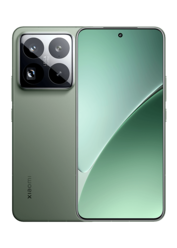
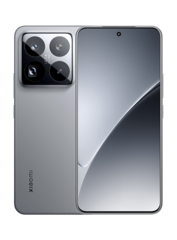

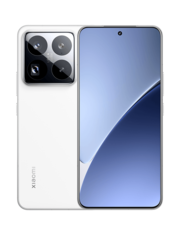
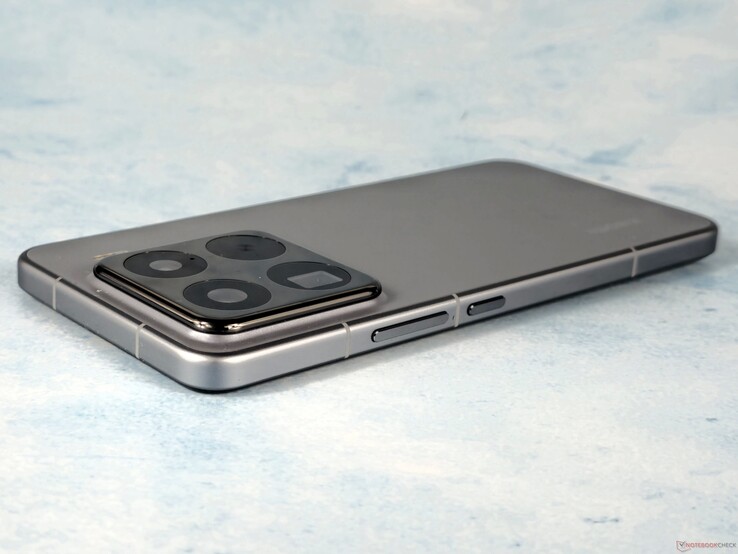






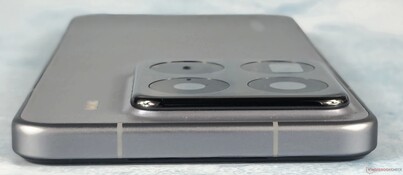
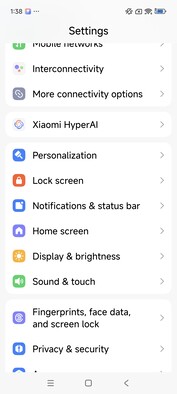
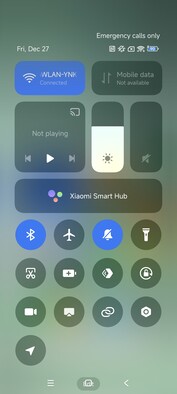
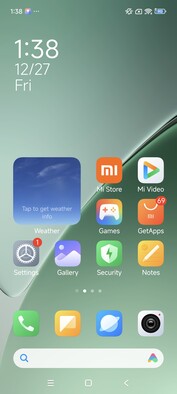


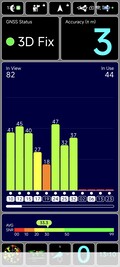





















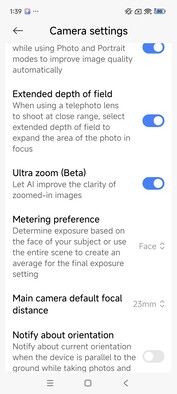
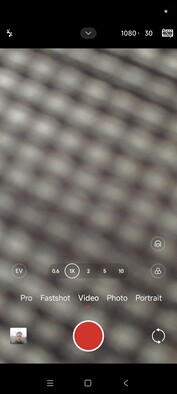







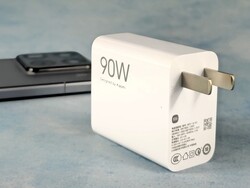



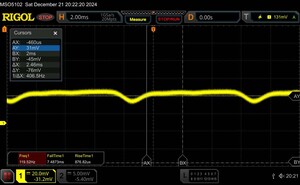

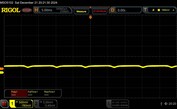


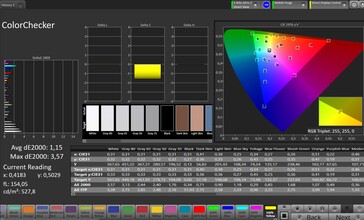
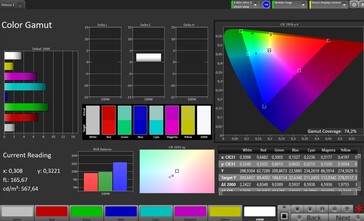
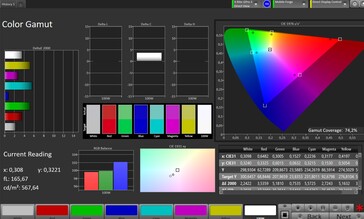
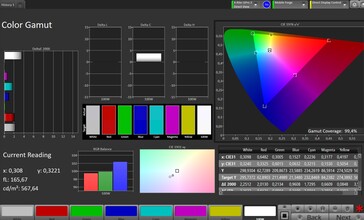
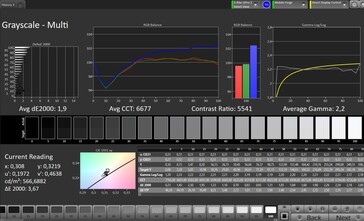
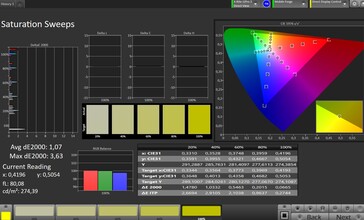
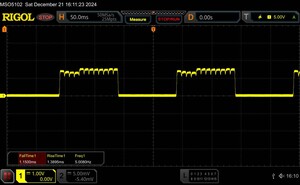
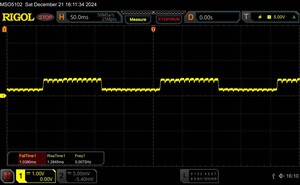
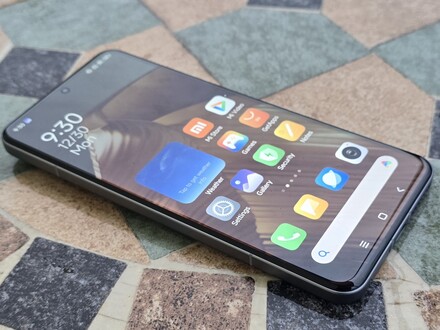
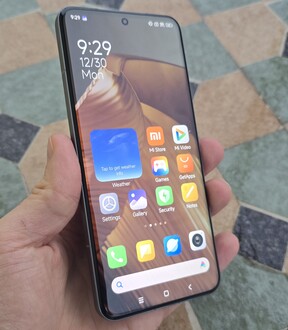



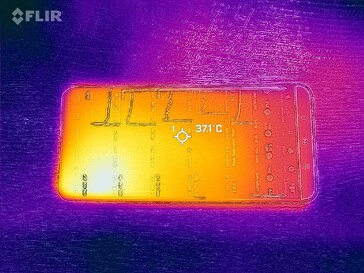
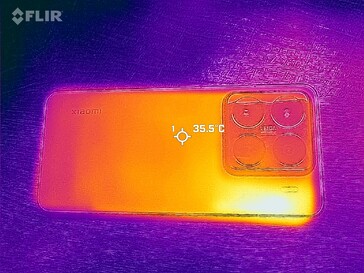
 Total Sustainability Score:
Total Sustainability Score: 










